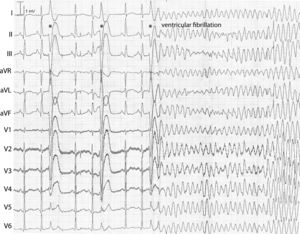DPP6: Difference between revisions
(Created page with "[[File:DPP6ECG.jpg|ECG recording of idiopathic ventricular fibrillation (IVF) in a risk haplotype carrier. The short coupled ventricular extrasystoles from the right ventricular ...") |
No edit summary |
||
| Line 1: | Line 1: | ||
[[File:DPP6ECG.jpg|ECG recording of idiopathic ventricular fibrillation (IVF) in a risk haplotype carrier. The short coupled ventricular extrasystoles from the right ventricular apex/lower free wall (indicated by asterisks) first result in compensatory pauses and then in IVF requiring external defibrillation]] | [[File:DPP6ECG.jpg|thumb|ECG recording of idiopathic ventricular fibrillation (IVF) in a risk haplotype carrier. The short coupled ventricular extrasystoles from the right ventricular apex/lower free wall (indicated by asterisks) first result in compensatory pauses and then in IVF requiring external defibrillation]] | ||
A new arrhythmia gene on chromosome 7q36, DPP6, is linked to familial IVF and shows a very malignant phenotype. This phenotype consists of cardiac arrest by IVF at young age, which is elicited by short coupled extrasystoles. While this gene has not earlier been related to cardiac arrhythmias, we are now able, for the first time, to identify presymptomatic family members at risk for future fatal events solely by genetic analysis. Affected patients can be offered preventive treatment accordingly. Therefore, when there is a family history of unexplained sudden cardiac deaths, we make the reader aware of this particular link to the DPP6 gene as it may enable risk stratification of the remaining family members. In addition, when closely coupled extrasystoles initiate ventricular fibrillation in the absence of other identifiable causes, a link to the DPP6 gene should also be suspected.<cite>Postema</cite> | A new arrhythmia gene on chromosome 7q36, DPP6, is linked to familial IVF and shows a very malignant phenotype. This phenotype consists of cardiac arrest by IVF at young age, which is elicited by short coupled extrasystoles. While this gene has not earlier been related to cardiac arrhythmias, we are now able, for the first time, to identify presymptomatic family members at risk for future fatal events solely by genetic analysis. Affected patients can be offered preventive treatment accordingly. Therefore, when there is a family history of unexplained sudden cardiac deaths, we make the reader aware of this particular link to the DPP6 gene as it may enable risk stratification of the remaining family members. In addition, when closely coupled extrasystoles initiate ventricular fibrillation in the absence of other identifiable causes, a link to the DPP6 gene should also be suspected.<cite>Postema</cite> | ||
==References== | ==References== | ||
Revision as of 19:37, 17 January 2012
A new arrhythmia gene on chromosome 7q36, DPP6, is linked to familial IVF and shows a very malignant phenotype. This phenotype consists of cardiac arrest by IVF at young age, which is elicited by short coupled extrasystoles. While this gene has not earlier been related to cardiac arrhythmias, we are now able, for the first time, to identify presymptomatic family members at risk for future fatal events solely by genetic analysis. Affected patients can be offered preventive treatment accordingly. Therefore, when there is a family history of unexplained sudden cardiac deaths, we make the reader aware of this particular link to the DPP6 gene as it may enable risk stratification of the remaining family members. In addition, when closely coupled extrasystoles initiate ventricular fibrillation in the absence of other identifiable causes, a link to the DPP6 gene should also be suspected.[1]
